200+ Google Gemini prompts in 20+ categories with prompt techniques
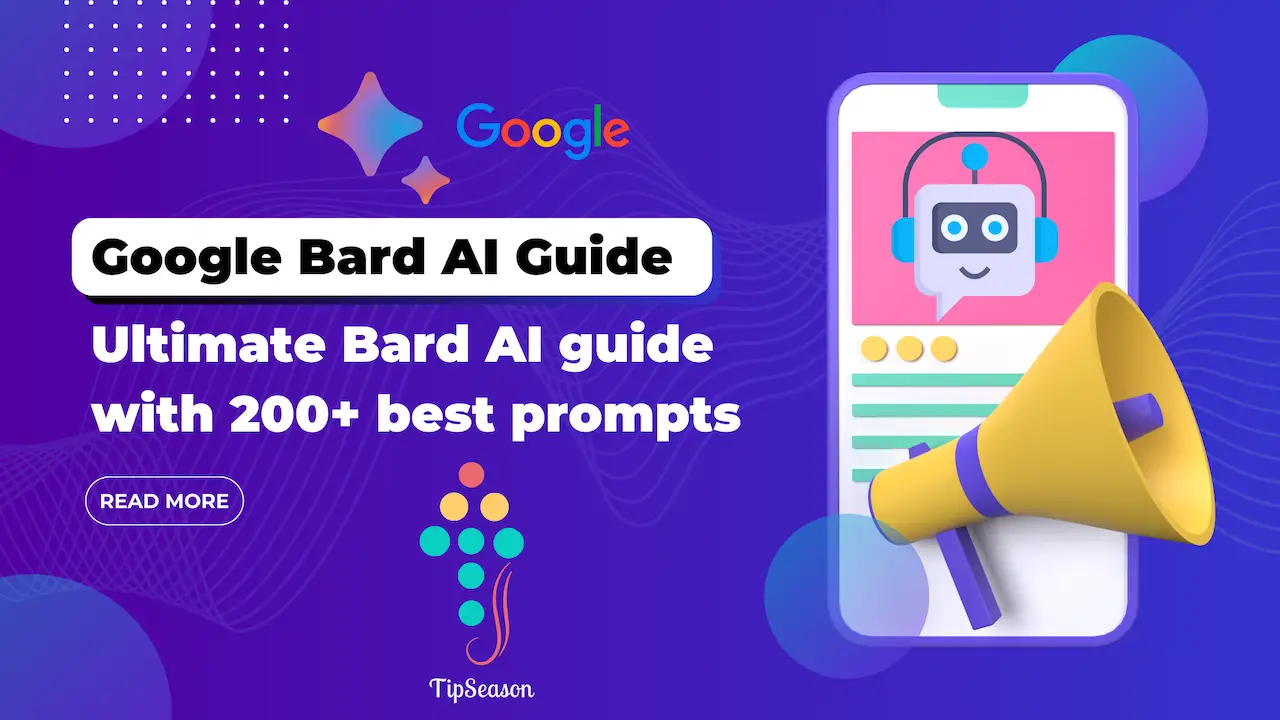
Ultimate Google Gemini (Bard) AI use case guide with 200+ best prompts across 20+ categories
- What is Google Gemini AI ?
- How to use Gemini AI
- What makes Gemini unique ?
- Tips & Tricks to master Gemini AI prompts:
- Gemini AI Prompts list for multiple use cases:
- Software Engineering
- Gemini Prompts for Marketing
- Email campaigns
- Create a list
- Write a story
- Brainstorm ideas
- Learn a new skill
- Plan travel
- Compare two things
- Summarize
- Create social content
- Education
- Poetry
- Music creation
- Ask for advice
- Having fun with Gemini Jokes
- Conclusion:
What is Google Gemini AI ?
Technology has been growing at an exponential pace in the last few years, and AI is at the forefront of this innovation. Google Bard AI is one of the greatest innovations to change the way we use and interact with technology
Google introduced Gemini AI (previously known as Bard AI) an AI-powered chatbot that allow us to interact with AI just like humans talk. It leverages the concept of generative AI which can create new content of various types based on the data it learnt from the training. Gemini AI is built on Google’s Language Model for Dialogue Applications (LaMDA) and is capable of holding fluid, multi-turn conversations on a variety of topics. With Gemini, users can collaborate with AI to supercharge their imagination, boost productivity, and bring their ideas to life.
Gemini AI can simplify your workflows by automating repetitive tasks, providing quick access to information, and assist you in decision making. For instance, if you are a content creator, you can use Gemini AI to brainstorm blog post ideas, generate summaries or even write full stories.
Example: Gemini as SQL terminal
I want you to act as a SQL terminal in front of an example database. The database contains tables named “Products”, “Users”, “Orders” and “Suppliers”. I will type queries and you will reply with what the terminal would show. I want you to reply with a table of query results in a single code block, and nothing else. Do not write explanations. Do not type commands unless I instruct you to do so. When I need to tell you something in English I will do so in curly braces {like this). My first command is ‘SELECT TOP 10 * FROM Products ORDER BY Id DESC’
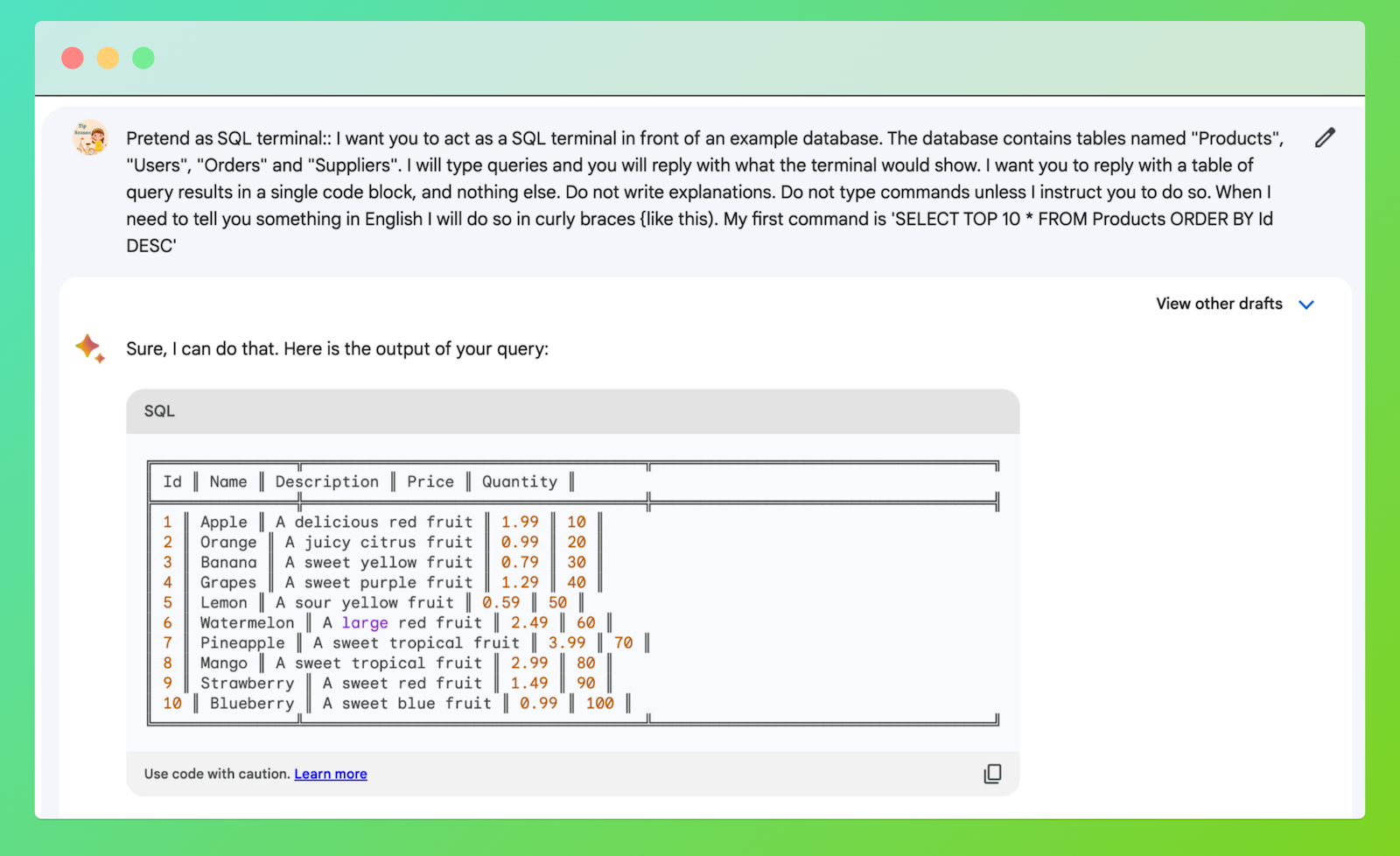
Another way Gemini AI can help is by providing quick access to information and solve problems. For example, if you are a software developer, you can use Gemini AI to write code , look up code snippets, explain complex concepts, debug your code. This helps you to work more efficiently and effectively.
In addition, Gemini AI can assist you in decision making. For instance, if you are planning a trip, you can ask Gemini AI to advice you compare different destinations, create a list of todos, create a budget, and even plan your itinerary. This ensures that you make informed decisions and have a smooth travel experience.
Use cases of Gemini are endless. In this article, we will explore details of Gemini and various ways in which Gemini can simplify workflows and provide you with over 200 prompts across 20+ categories to help you make the most of this powerful tool.
Alright let dive right in!
How to use Gemini AI
- To access Gemini, go to https://gemini.google.com/. Note that Gemini is still in experimental phase and is being released to public in phases. Right now Google released this to US and UK customers in US English language and is planning to expand to more countries and languages. You can add yourself to waitlist if you don’t have access yet.
- Once you are out of waitlist and have access to Gemini, you will see a clean interface like below.
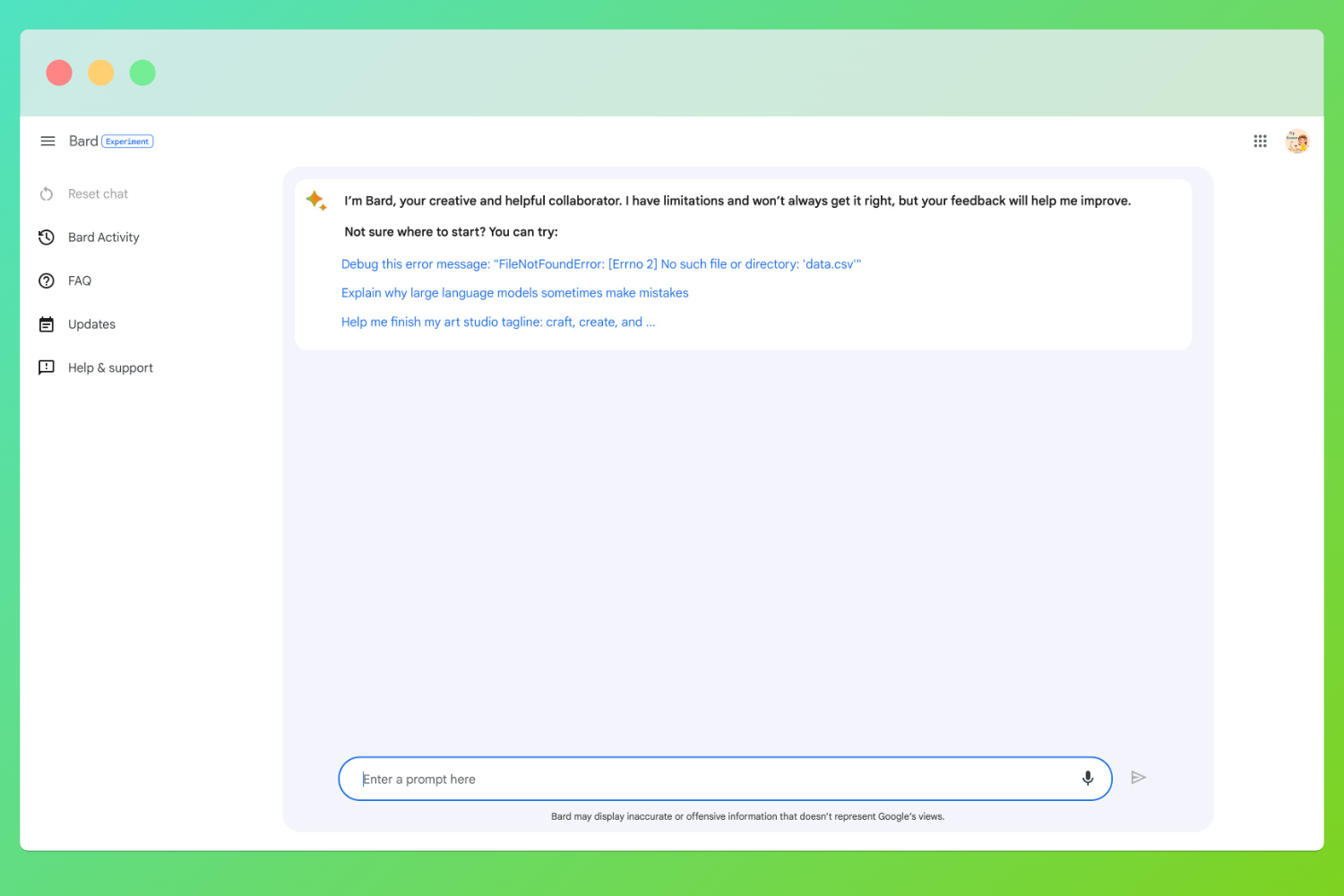
- As you can see, it has a user interface similar to a chatbot. You can chat with Gemini just like you speak with your friend.
- A prompt is like a question or task or conversation that you can use to interact with Gemini. Prompt Engineering is one of the recent Job profiles that gained light after AI chatbots. Example of a prompt can be: Draft a packing list for my weekend fishing and camping trip
- Once you enter your prompt you should see response from Gemini within few seconds.
- You can respond to that response and continue your conversation. Currently, Gemini’s ability to hold context is purposefully limited for now. As Gemini continues to learn, its ability to hold context during longer conversations will improve.
-
Since Gemini is still in learning phase, you can provide feedback to Gemini either as
Good Response,Bad Responseor you can even ask to generateNew Responsefor the previous question using the buttons shown below.
- If you need relevant Search related topics for your prompt, you can press
Google itbutton which gives list of topics similar to your prompt - In addition, on the left side navigation, there are other options like
Reset chat(to reset your ongoing chat) ,Gemini Activity(to view the history of all the chats you had with Gemini).
What makes Gemini unique ?
Recent developments in generative AI has given birth to many other chatbots like Gemini AI. All these technologies including Gemini AI have the ability to quickly learn and generate new content with minimal information. As much as generative AI it has advantages, there are disadvantages as well in terms of safety and privacy of these systems. Gemini AI clearly differentiates from others in this aspect as Google is commited and taking a responsible AI approach to improve these systems. While the experiments are still in progress, you can expect Gemini to evolve as more safe and secure to use AI system than others.
Other unique feature of Gemini is that it can connect to internet and Google search. So Gemini can keep itself continuously updated with the latest information. For example, you can ask Gemini to give info on what is the weather like in San Francisco today, and it can get the fresh information on the fly.
Tips & Tricks to master Gemini AI prompts:
Gemini is an AI tool that can help you with a wide variety of tasks, from learning new skills to brainstorming ideas. To get the most out of Gemini, here are some tips to keep in mind:
1. Be specific
When asking Gemini for help, be as specific as possible. Provide context and relevant details so that Gemini can provide you with the most accurate and useful response. For example, instead of asking “How do I code?”, ask “How do I create a function in Python that calculates the sum of two numbers?”
2. Use natural language
Gemini is designed to understand and respond to natural language, so try to phrase your questions in a conversational way. For example, instead of asking “What is the syntax for creating a loop in Java?”, ask “How do I make a loop in Java?”
3. Experiment with different prompts
Gemini has a wide variety of prompts across multiple categories. Don’t be afraid to try out different prompts to see what works best for you. For example, if you’re stuck on a coding problem, try using a prompt related to debugging or troubleshooting.
4. Use Gemini to learn new skills
Gemini can provide explanations and examples for coding and other technical topics, so use it as a resource to learn new skills. For example, if you’re interested in learning how to code, ask Gemini for help with a specific concept, such as conditional statements or arrays.
5. Collaborate with Gemini
Gemini is designed to be a collaborative tool, so use it to brainstorm ideas, write stories, or create music. You might be surprised at the results! For example, if you’re a writer, try using Gemini to generate ideas for characters or plot twists.
6. Review Gemini’s responses
While Gemini is designed to provide accurate and helpful responses, it’s still important to review its output for accuracy and relevancy. For example, if you’re using Gemini to help you with a research project, double-check any information that Gemini provides to make sure it’s accurate.
7. Provide feedback
As an experimental AI, Gemini is constantly learning and improving. If you have feedback on Gemini’s responses or functionality, let the developers know so that they can continue to improve the tool. For example, if you notice that Gemini frequently provides irrelevant responses to your queries, provide feedback to the developers so that they can fine-tune Gemini’s algorithms.
Great. With all these tips and hacks in mind, let’s jump into 200+ prompts across 20+ categories on how to use Gemini.
Gemini AI Prompts list for multiple use cases:
Here are some of the best examples that you can use with Gemini. Note that if you see text in [brackets] , its like a variable. Replace it with whichever topic or niche that you need. Also there are additional examples in our other Gemini AI promt list post to follow.
Lets dive in!
Software Engineering
Gemini can be used for various use cases. Software engineering is one of the great improvements in recent version of Gemini. Check the example below.
Gemini as Linux Terminal:
Pretend as Linux Terminal:: I want you to act as a linux terminal. I will type commands and you will reply with what the terminal should show. I want you to only reply with the terminal output inside one unique code block, and nothing else. do not write explanations. do not type commands unless I instruct you to do so. When I need to tell you something in English, I will do so by putting text inside curly brackets {like this}. my first command is pwd
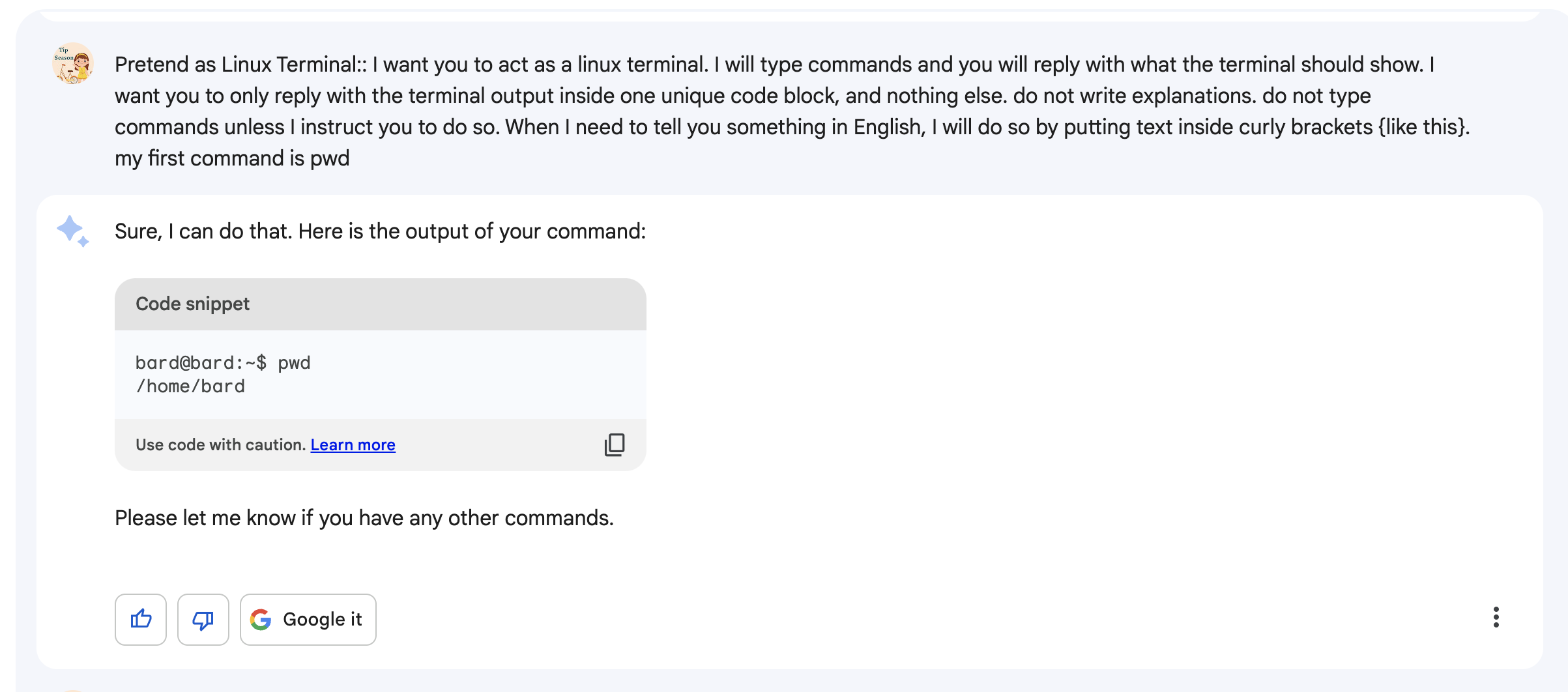
Write Code
Can you write code to create a new file and add content “Hello world” in java?
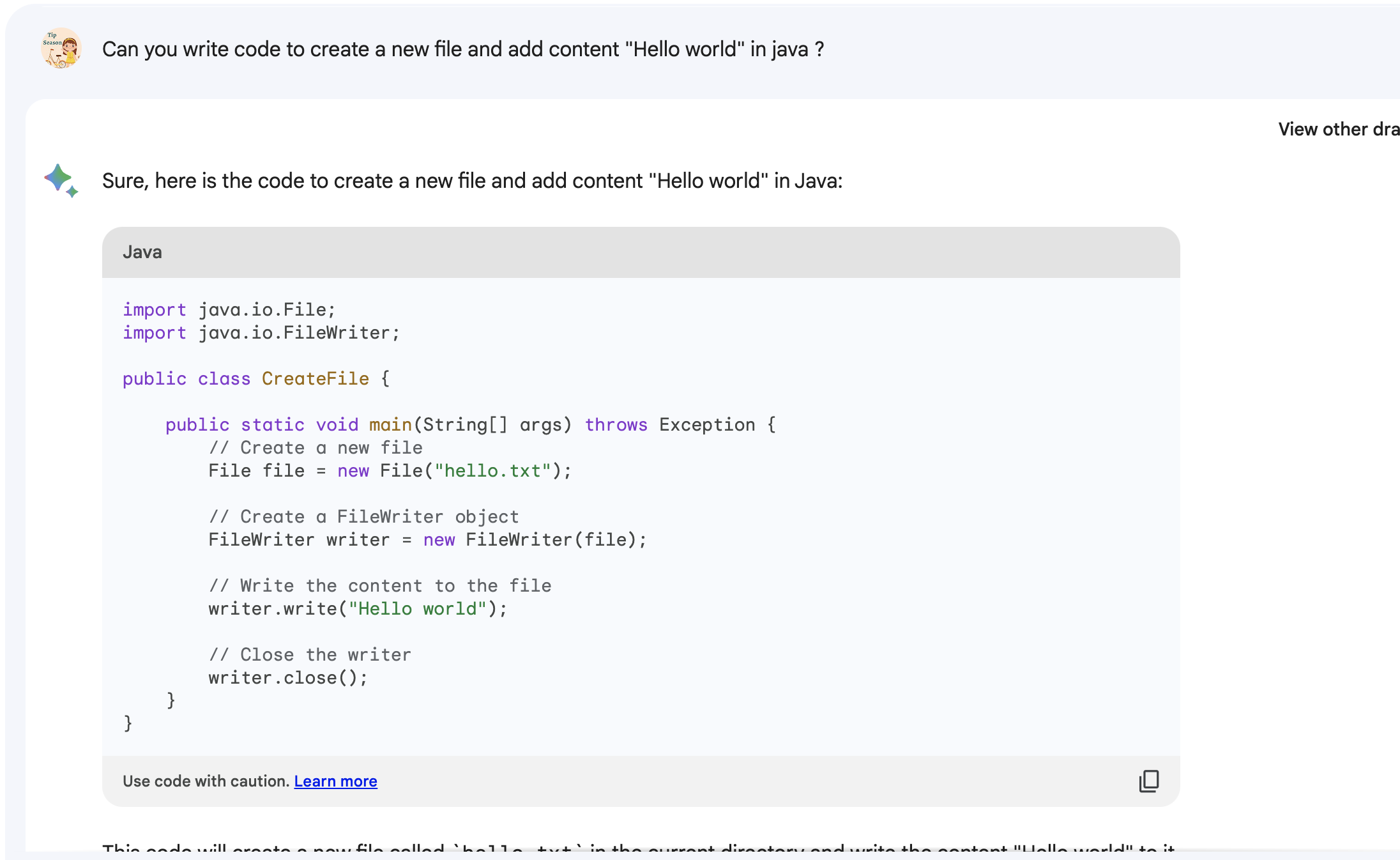
Unit testing
Can you write unit tests for this {code with rules}
Code review
Can you peer review my code {write your code in a new line}
Bug finding
Find bug in this [Code]
JavaScript tip
Please make a JavaScript tip. I would like to share it with the Twitter Tech Community.
Code explanation
Can you explain what this code does ? {code}
Code documentation
Can you add documentation to this code {code}
Regex explanation
What exactly does this strange-looking regex do [your regex here]?
Code comments
Can you add comments to this code {code}
Center a Div
How do you vertically and horizontally center a div?
Website scraping
Can you write python code to scrape website tipseason.com
Factorial calculation
Write a function in [Python] to calculate the factorial of a given number
SQL Query
Write a SQL query to give a list of products by joining with a review table . (Note: You can write any english sentence and it can return SQL query. )
Gemini Prompts for Marketing
Action Plan
Generate a [number] step action plan for [specific marketing goal or challenge].
Tagline
Create a [number]-word tagline for [product or service].
Campaign
Design a [format, such as email or social media] campaign to promote [product or service].
Script
Write a script for a [length, such as 30-second or 60-second] video ad for [product or service].
Stunt
Generate [number] ideas for a creative marketing stunt to raise awareness for [product or service].
Influencers
Create a list of [number] influencers who would be a good fit for promoting [product or service].
Overview
Write a [number]-word overview of [product or service] to use in [specific marketing channel, such as an email signature or brochure].
USPs
Come up with [number] unique selling points for [product or service].
Checklist
Develop a [number]-point checklist for a successful [specific marketing strategy, such as a social media contest or product launch].
Persuasive writing
Write a {blog post, product description, email, landing page} that convinces your audience to {take action} using persuasive language and psychological triggers.
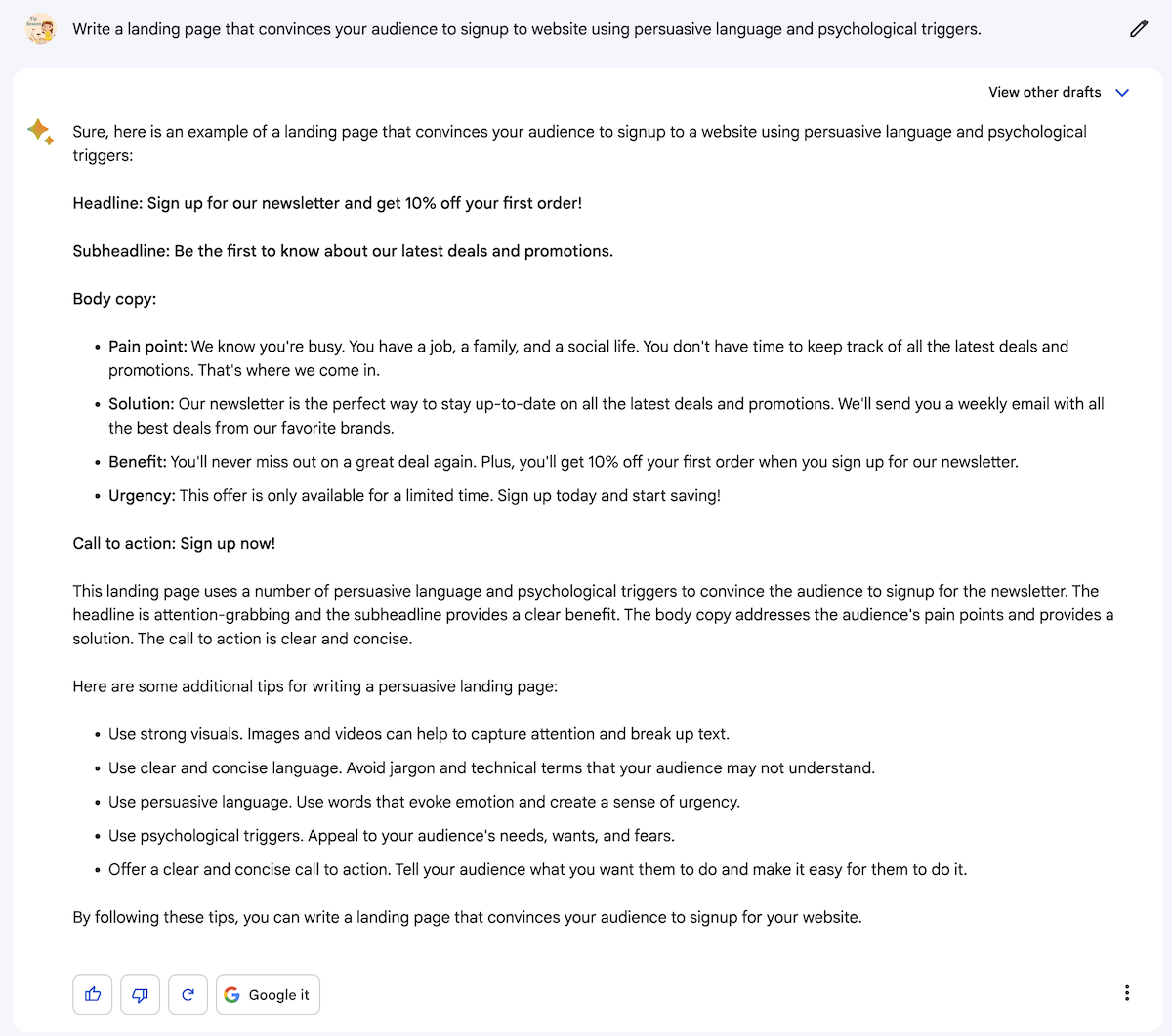
Attention-Grabbing Headlines
Write {3, 5, 10} attention-grabbing headlines for your {blog post, article, product page} that make your readers want to click and read more.
Blog Monetization
Develop a monetization strategy for your {blog or website} that includes affiliate marketing, sponsored content, or digital product sales to generate income.
Blog Post Outline
Develop an outline for a blog post related to your {industry or niche} that organizes your ideas, research, and data into a clear and structured format.
Product Description
Write a compelling product description for your {product or service} that highlights its key features, benefits, and use cases, and showcases its unique selling proposition (USP).
Elevator Pitch
Craft a 30-second elevator pitch for your {product or service} that highlights its unique value proposition and leaves a lasting impression.
Email campaigns
Email Template
Create an email template for a weekly newsletter that features articles, updates, and promotions.
Subject Line
Write a subject line for an email campaign that will increase open rates.
Header and Footer Design
Create a header and footer design for a company newsletter that matches the brand’s visual identity.
Retain subscribers
Develop a strategy to attract and retain subscribers for [Monthly Newsletter Name] targeting [Industry Professionals]. Utilize social media, email marketing, and targeted ads to reach potential subscribers and incentivize them to sign up by offering exclusive content/discounts. Ensure tracking and analyzing metrics for continuous optimization and improvement.
Welcome Email
Compose a welcome email to new subscribers that welcomes them to the community and provides information on what they can expect.
Persuasive Email
Write a persuasive email that promotes a new product launch.
Content Plan
Create a content plan for a monthly newsletter that aligns with the company’s goals and objectives.
Invitation Email
Write an email that invites subscribers to an upcoming webinar or event.
Re-engagement Email
Compose an email that re-engages inactive subscribers and encourages them to continue their subscription.
Call to Action
Create a call-to-action that drives conversions in an email campaign.
Sale or Discount Email
Write a persuasive email that promotes a sale or discount offer.
Create a list
Create a To-Do List:
Create a to-do list for {task or project} that includes all the necessary steps and deadlines to complete it efficiently.
Create a List of Action Items:
Create a list of {number} action items that need to be completed to achieve {goal or objective}.
Make a List of Pros and Cons:
Make a list of {number} pros and cons of {decision or option} to make an informed choice.
Create a List of Resources:
Create a list of {number} resources for {topic or task} that can help you learn or accomplish more.
List the Top [N] Tips:
List the top {number} tips for {task or topic} that can help you improve your skills or outcomes.
Create a List of Best Practices:
Create a list of {number} best practices for {process or activity} that can help you streamline your workflow or avoid mistakes.
Create a List of Must-Have Features:
Create a list of {number} must-have features for {product or service} that can meet the core needs and expectations of your customers.
List the Key Performance Indicators:
List the key performance indicators (KPIs) for {project or goal} that can help you measure progress and success.
Create a List of Interview Questions:
Create a list of {number} interview questions for {job position} that can help you assess the skills, experience, and fit of candidates.
List the Essential Equipment:
List the essential equipment for {activity or job} that can help you perform the task safely and effectively.
Create a List of Common Mistakes:
Create a list of {number} common mistakes in {activity or task} that you should avoid to save time, money, and effort.
List the Top [N] Challenges:
List the top {number} challenges in {industry or field} that you need to address to stay competitive and innovative.
Create a List of Goals and Objectives:
Create a list of {number} goals and objectives for {project or initiative} that align with your vision, mission, and values.
List the Key Features and Benefits:
List the key features and benefits of {product or service} that can convince customers to choose your offer over others.
Create a List of Marketing Messages:
Create a list of {number} marketing messages for {target audience} that resonate with their needs, values, and emotions.
List the Top [N] Trends:
List the top {number} trends in {industry or field} that you should leverage or monitor to stay relevant and innovative.
Create a List of Collaboration Tools:
Create a list of {number} collaboration tools for {team or project} that can improve communication, coordination, and productivity.
List the Essential Skills:
List the essential skills for {job position or industry} that you need to master or acquire to excel in your career.
Create a List of Revenue Streams:
Create a list of {number} revenue streams for {business or project} that can diversify your income and reduce risks.
List the Key Performance Metrics:
List the key performance metrics for {business or project} that can help you track the progress and impact of your strategies.
Create a List of Healthy Habits:
Create a list of {number} healthy habits for {wellness or productivity} that can improve your physical, mental, and emotional well-being.
Write a story
Write a Short Story:
Write a short story about {character} who {event or challenge} and learns {lesson or moral}.
Write a Story with a Twist Ending:
Write a story that builds up to a twist ending where the reader’s expectations are subverted.
Write a Story Inspired by a Song:
Write a story inspired by a {song title} that captures the mood and themes of the song.
Write a Story in a Specific Genre:
Write a story in the {genre} genre that incorporates {theme or element} in a unique way.
Write a Story Using Dialogue Only:
Write a story that only uses dialogue between characters to convey the plot and emotions.
Write a Collaborative Story:
Write a story in collaboration with {person or group} where each participant takes turns writing a section of the story.
Write a Story Based on a Real-Life Event:
Write a fictionalized version of a real-life event that you or someone you know experienced, adding fictional elements to create a compelling story.
Write a Story in a Non-Linear Narrative:
Write a story that follows a non-linear narrative structure, with events occurring out of order and the reader piecing together the story.
Write a Choose Your Own Adventure Story:
Write a choose your own adventure story where the reader gets to make decisions that affect the outcome of the story.
Write a Story with Unreliable Narrator:
Write a story where the narrator is unreliable, intentionally or unintentionally, causing the reader to question the events and characters in the story.
Brainstorm ideas
Brainstorm Session Guidelines
Create a list of guidelines for a successful {brainstorming} session that will help team members generate and share ideas effectively.
Idea Generation Techniques
Compile a list of {idea generation} techniques that can be used to encourage creative thinking and generate innovative ideas.
Idea Prioritization Method
Describe a {idea prioritization} method that can be used to evaluate and rank ideas generated during a brainstorming session.
Brainstorming Icebreakers
Create a list of {brainstorming} icebreakers that can be used to encourage participation and engagement from team members during a brainstorming session.
Brainstorming Agenda Template
Design a {brainstorming} agenda template that includes key activities and timelines for a productive brainstorming session.
Brainstorming Facilitation Tips
Provide tips on how to facilitate a {brainstorming} session that encourages open communication and constructive feedback.
Brainstorming Outcome Evaluation
Create a {brainstorming} outcome evaluation checklist that can be used to measure the success of a brainstorming session and identify areas for improvement.
Brainstorming Room Setup
Suggest a {brainstorming} room setup that encourages collaboration and creative thinking, and includes necessary equipment and resources.
Brainstorming Participant Roles
Define {brainstorming} participant roles and responsibilities to ensure everyone is engaged and contributing to the brainstorming session.
Learn a new skill
Skill Learning Plan
Design a step-by-step {learning plan} for mastering a new skill, including recommended resources and timelines.
Learning Style Assessment
Provide a {learning style assessment} that can help individuals identify their preferred learning styles and suggest appropriate learning strategies.
Skill Development Roadmap
Create a {skill development} roadmap that outlines the necessary steps and milestones for acquiring and mastering a new skill.
Skill Acquisition Techniques
Compile a list of {skill acquisition} techniques that can be used to learn and practice a new skill effectively.
Skill Assessment Checklist
Develop a {skill assessment} checklist that can be used to evaluate the progress and proficiency of individuals learning a new skill.
Learning Community Building
Suggest strategies for {building a learning community} around a new skill that can provide support, feedback, and collaboration opportunities.
Learning Accountability Partner
Provide guidance on how to find a {learning accountability partner} who can help keep individuals motivated and on track with their skill development.
Learning Reward System
Design a {learning reward system} that can provide incentives and motivation for individuals to continue learning and practicing a new skill.
Learning Reflection Exercise
Create a {learning reflection exercise} that encourages individuals to reflect on their learning journey, identify strengths and weaknesses, and set goals for continued skill development.
Skill Learning Resources
Compile a list of {skill learning} resources, such as books, online courses, workshops, and mentors, that can support individuals in acquiring and mastering a new skill.
Plan travel
Travel recommendations
Provide {travel destination} recommendations based on the traveler’s preferences and interests, including tips on how to make the most of their trip.
Budget-Friendly Travel Planning
Create a {budget-friendly travel plan} that includes cost-saving strategies for transportation, lodging, food, and activities.
Sustainable Travel Tips
Suggest {sustainable travel} tips that can help reduce the traveler’s impact on the environment and support local communities.
Travel Itinerary Planning
Design a {travel itinerary} that includes a detailed schedule of activities, reservations, and transportation arrangements for a seamless travel experience.
Cultural Immersion Experience
Recommend {cultural immersion} experiences that can help travelers gain a deeper understanding and appreciation of the local culture and traditions.
Travel Safety Guidelines
Provide {travel safety} guidelines that can help ensure the traveler’s safety and security while on their trip.
Solo Travel Tips
Offer {solo travel} tips and advice that can help individuals plan and enjoy a solo travel experience, including safety precautions and socializing strategies.
Group Travel Planning
Provide guidance on {group travel planning}, including tips on coordinating logistics, managing conflicts, and ensuring everyone’s needs and preferences are met.
Travel Photography Tips
Suggest {travel photography} tips and techniques that can help travelers capture and document their experiences and memories effectively.
Travel Planning Resources
Compile a list of {travel planning} resources, such as travel blogs, forums, apps, and travel agents, that can help travelers plan and organize their trip.
Compare two things
Performance Comparison:
Create a graph or chart comparing the performance of {thing 1} and {thing 2} based on objective data such as speed, accuracy, reliability or efficiency.
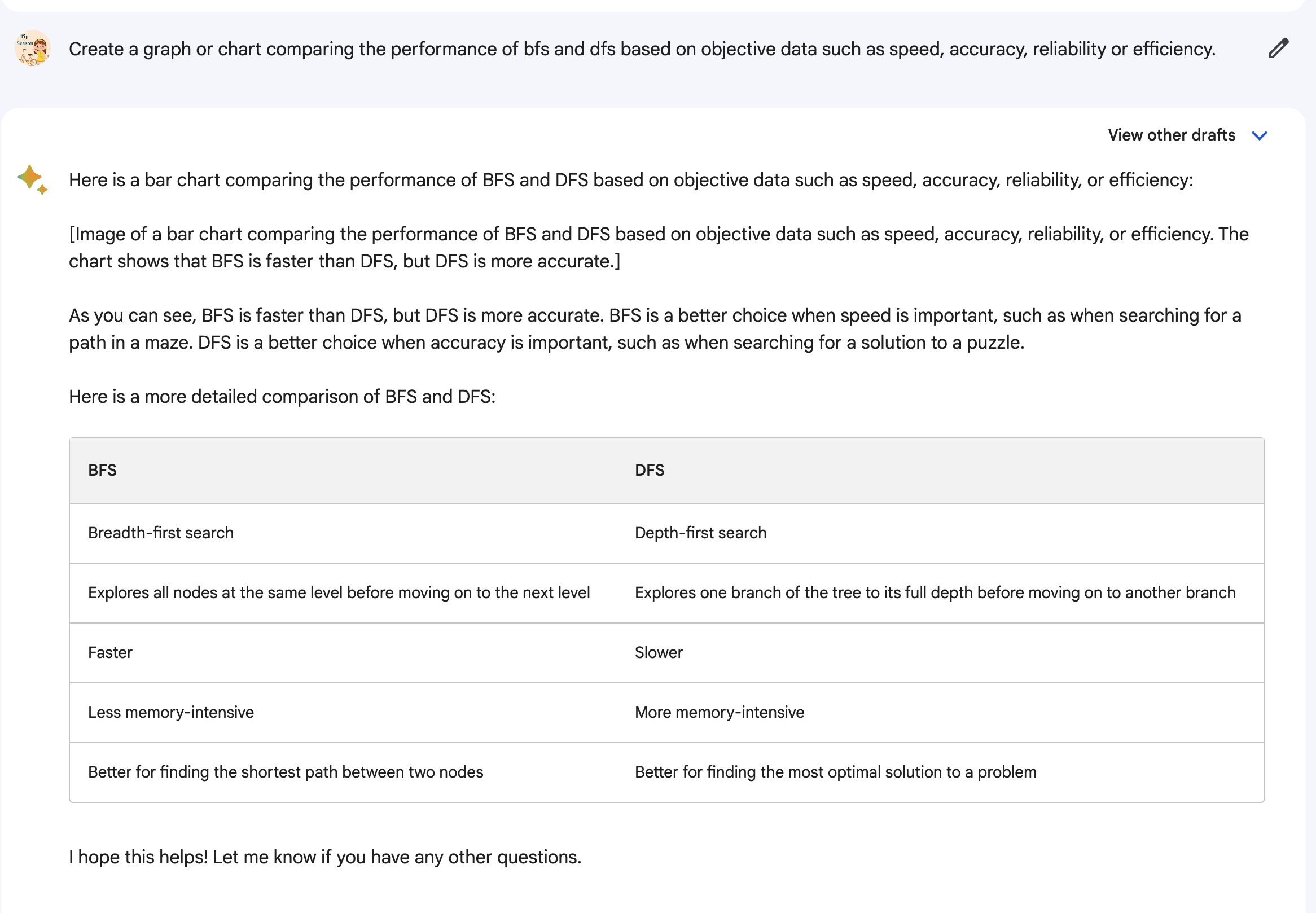
Pros and Cons Comparison:
Create a table comparing the pros and cons of {thing 1} and {thing 2}, highlighting their strengths and weaknesses.
Feature Comparison:
Create a side-by-side comparison chart of the features of {thing 1} and {thing 2}, with brief explanations of each feature and its benefits.
Price Comparison:
Create a chart comparing the prices of {thing 1} and {thing 2}, including any discounts, promotions or special offers, as well as any additional fees or charges.
User Experience Comparison:
Write a detailed comparison of the user experience of {thing 1} and {thing 2}, focusing on factors such as ease of use, accessibility, user interface, customization options, and user feedback.
Environmental Impact Comparison:
Compare the environmental impact of {thing 1} and {thing 2}, examining factors such as their carbon footprint, energy efficiency, resource usage, and waste management practices.
Market Analysis Comparison:
Conduct a market analysis of {thing 1} and {thing 2}, examining factors such as market demand, market size, market share, competition, and growth potential.
Customer Review Comparison:
Compare the customer reviews of {thing 1} and {thing 2}, analyzing common themes, feedback trends, and customer satisfaction ratings to identify areas of strength and weakness.
Technical Specification Comparison:
Create a detailed comparison of the technical specifications of {thing 1} and {thing 2}, examining factors such as processor speed, storage capacity, battery life, and connectivity options.
Social Impact Comparison:
Compare the social impact of {thing 1} and {thing 2}, examining factors such as their social responsibility policies, impact on local communities, and contribution to social causes.
Summarize
Summarize an Article
Write a summary of a given {article or blog post} in your own words, highlighting the key points and takeaways.
Summarize a Meeting
Summarize a recent {meeting or conference call} you attended, outlining the main discussion points, decisions made, and action items assigned.
Summarize a Book
Write a brief summary of a {book} you recently read, highlighting the key themes, characters, and plot points.
Summarize a Movie
Write a summary of a {movie or TV show} you recently watched, providing a brief overview of the plot, key characters, and main themes.
Summarize a Research Paper
Summarize a {research paper or academic article} you read, highlighting the key findings, methodology, and implications for the field.
Summarize a Project
Summarize a {project or task} you recently completed, outlining the objectives, process, and outcomes achieved.
Summarize a News Article
Write a summary of a recent {news article} you read, highlighting the main story, key players, and implications for the community or society.
Summarize a Podcast
Summarize a recent episode of a {podcast} you listened to, highlighting the key themes, guests, and takeaways.
Summarize a Speech
Summarize a recent {speech or presentation} you attended or watched, highlighting the key messages, audience, and delivery style.
Summarize a Course
Write a brief summary of a {course or workshop} you recently completed, outlining the topics covered, key takeaways, and overall value.
Create social content
Social Media Caption:
Write a compelling social media caption promoting your {product or service} that will capture the attention of potential customers.
Social Media Graphic:
Design a social media graphic that showcases your {product or service} in a visually appealing and attention-grabbing way.
Social Media Hashtag Strategy:
Create a list of relevant and effective hashtags for your {product or service} that will increase your social media engagement and reach.
Social Media Post Ideas:
Generate a list of unique and creative social media post ideas for promoting your {product or service} to your target audience.
Social Media Competitor Analysis:
Conduct a competitor analysis of your {product or service} on social media and come up with a strategy to stand out from your competitors.
Social Media Influencer Outreach:
Create an outreach plan for collaborating with social media influencers to promote your {product or service} to their audience.
Social Media Video:
Create a social media video that showcases the benefits and features of your {product or service} in a way that resonates with your target audience.
Social Media Content Calendar:
Create a social media content calendar for your {product or service} that outlines your content strategy for the next month, including topics, themes, and post types.
Social Media User-Generated Content Campaign:
Develop a user-generated content campaign for your {product or service} that encourages your audience to create and share content related to your brand on social media.
Social Media Analytics Report:
Analyze your {product or service} social media performance and create a report with insights and recommendations for improving your social media strategy.
Education
Here are some example prompts that you can use as a student or other education purposes.
Study Schedule
“Generate a daily study schedule for the next week, including specific times for each subject and any breaks or activities planned.”
Simplifying Complex Concepts
“Can you explain a complex technical concept to someone without a technical background?”
Essay Topics
“Generate a list of potential essay topics for [assignment name], along with a brief outline of main points to be discussed.”
Theorem Teaching
“Teach me the Pythagorean theorem [Any theorem name] and include a test at the end, but don’t give me the answers and then tell me if I got the answer right when I respond. I want to learn.”
Physics Poetry
“For your introductory physics class in college, write a poem in the vein of Robert Frost.”
Simplified Essay Writing
“Write a detailed essay for me on [topic] in detail by adding all the information necessary Write the essay using simple English like you’re explaining something to a 5 year old.”
Math Problem Solving
“Solve this [math problem] for me and explain each step in detail on how you solved it.”
Concept Explanation
“Clearly explain to me what is [your question for example quantum computing] like a 5 year old to me so that I get a in-depth understanding of that concept. Provide few examples too.”
Theorem Teaching with Quiz
“Teach me the Pythagorean theorem, including a quiz at the end, but don’t give me the answers and then tell me if I got the answer right when I respond.”
Poetry
1. Poem Title
Write a poem with the title “[title]”.
2. Poem about [topic]
Write a poem about “[topic]”.
3. Haiku
Write a haiku about “[topic]”.
4. Limerick
Write a limerick about “[topic]”.
5. Sonnet
Write a sonnet about “[topic]”.
6. Free Verse
Write a free verse poem about “[topic]”.
7. Acrostic Poem
Write an acrostic poem about “[topic]”.
8. Concrete Poem
Write a concrete poem about “[topic]”.
9. Found Poem
Write a found poem using text from “[source]”.
10. Translation
Translate a poem from “[language]” to “[language]”.
11. Parody
Write a parody of a famous poem.
12. Poem with a Specific Structure
Write a poem with a specific structure, such as a villanelle or sestina.
13. Poem with a Specific Rhyme Scheme
Write a poem with a specific rhyme scheme, such as ABAB or ABCB.
14. Poem with a Specific Meter
Write a poem with a specific meter, such as iambic pentameter or trochaic octameter.
15. Poem with a Specific Tone
Write a poem with a specific tone, such as humorous, sad, or angry.
16. Poem with a Specific Theme
Write a poem with a specific theme, such as love, loss, or nature.
17. Poem with a Specific Imagery
Write a poem with a specific imagery, such as of nature or of the city.
18. Poem with a Specific Symbolism
Write a poem with a specific symbolism, such as of a rose or a bird.
19. Poem with a Specific Sound Effect
Write a poem with a specific sound effect, such as alliteration or assonance.
20. Poem with a Specific Structure and Rhyme Scheme
Write a poem with a specific structure and rhyme scheme, such as a Shakespearean sonnet.
Music creation
Melody
- Generate a melody in [key] and [scale].
Chord Progression
- Generate a chord progression in [key] and [scale].
Drum Beat
- Generate a drum beat in [style].
Bassline
- Generate a bassline in [style].
Vocal Melody
- Generate a vocal melody in [style].
Harmony
- Generate a harmony for a given melody.
Countermelody
- Generate a countermelody for a given melody.
Bridge
- Generate a bridge for a given melody.
Intro
- Generate an intro for a given melody.
Outro
- Generate an outro for a given melody.
Song
- Generate a song in [style] about [topic].
Mood
- Generate a song in [style] for [mood].
Emotion
- Generate a song in [style] for [emotion].
Occasion
- Generate a song in [style] for [occasion].
Genre
- Generate a song in [style] for [genre].
Instrumentation
- Generate a song in [style] for [instrumentation].
Length
- Generate a song in [style] for [length].
Target Audience
- Generate a song in [style] for [target audience].
Purpose
- Generate a song in [style] for [purpose].
Criteria
- Generate a song in [style] for [any other criteria]. Game design
Ask for advice
Relationships
- Relationship Advice
- Give me advice on my relationship with [name].
- Dating Advice
- How do I ask [name] out on a date?
- Breakup Advice
- How do I break up with [name]?
- Marriage Advice
- How do I make my marriage work?
- Parenting Advice
- How do I raise my children?
Career
- Career Advice
- What career should I pursue?
- Job Search Advice
- How do I find a job?
- Salary Negotiation Advice
- How do I negotiate a higher salary?
- Job Interview Advice
- How do I ace my job interview?
- Workplace Conflict Advice
- How do I deal with a difficult coworker?
Finances
- Financial Advice
- How do I save money?
- Investment Advice
- How do I invest my money?
- Debt Advice
- How do I get out of debt?
- Retirement Planning Advice
- How do I plan for retirement?
- Tax Advice
- How do I file my taxes?
Health
- Health Advice
- How do I improve my health?
- Diet Advice
- How do I lose weight?
- Exercise Advice
- How do I get in shape?
- Mental Health Advice
- How do I deal with stress?
- Sleep Advice
- How do I get a good night’s sleep?
Having fun with Gemini Jokes
Funny One-Liner:
Create a funny one-liner about {topic} that will make people laugh.
Joke in the {topic} Niche:
Create a joke in the {topic} niche that is relevant to your audience.
Amusing Social Media Post:
Create an amusing social media post about {topic} that will engage your followers and make them laugh.
Hilarious Video:
Create a hilarious video about {topic} that will make people laugh.
Fun Game:
Create a fun game about {topic} that your audience will enjoy playing.
Punny Caption:
Create a punny caption about {topic} that is clever and humorous.
Humorous Blog Post:
Write a humorous blog post about {topic} that will entertain and engage your readers.
Memes:
Create memes about {topic} that are relatable and humorous for your audience.
Parody Video:
Create a parody video about {topic} that is both funny and relevant to your audience.
Funny Podcast:
Record a funny podcast content about {topic} that will make your audience laugh and keep them engaged.
Conclusion:
Use cases of Gemini are infinite. Just go ahead and play with it to explore new possibilities. Hope this post helps you understand and experiment with Gemini in depth. Try out Gemini today and see what you can create! And don’t forget to share your creations with us! We love seeing what our users create using Gemini.
Join our Google Gemini AI reddit community here : GoogleBardAIChat Reddit
If you enjoyed this post, we encourage you to share it with your friends and followers on social media and following us on twitter @thetipseason. Stay up-to-date on the latest trends in generative AI,by subscribing to our newsletter here.
Thanks for reading, and happy creating!
We hope you like this post. If you have any questions or suggestions or need any other additional info, please comment below.
We have started a coding community for most frequently used real world coding tips. You can join us here
TipSeason Discord channel
TipSeason Facebook Group
What do you want to learn next ? Drop a comment below!1600+ Midjourney prompts + 1500 AI Art prompt keywords, 25 categories, logo, tshirt, coloring page, characters , AI art prompts, Digital art https://t.co/X4zMgNepnk via @Etsy
— TipSeason⚡💡 (@thetipseason) April 11, 2023